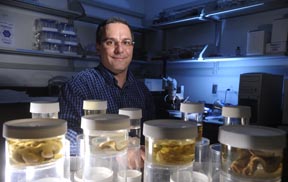University of Alabama at Birmingham biologist Robert Thacker, Ph.D., is part of an interdisciplinary team developing a digital Tree of Life that will enable scientists to see the relationships between organisms at a glance. The tools will capture data in all areas of comparative biology along multiple evolutionary, space and time scales.
 “The idea is that we will be able to accelerate science quickly and easily by sharing data and the way it is analyzed. And that will encourage scientists to try new ideas, find new answers and enhance the quality of research in multiple fields of science,” Thacker says.
“The idea is that we will be able to accelerate science quickly and easily by sharing data and the way it is analyzed. And that will encourage scientists to try new ideas, find new answers and enhance the quality of research in multiple fields of science,” Thacker says.
The project, Arbor: Comparative Analysis Workflows for the Tree of Life, is part of the National Science Foundation’s $13 million Assembling, Visualizing and Analyzing the Tree of Life program, AVAToL. The Arbor team will receive $4 million; $500,000 is dedicated to the work of Thacker, a professor in the UAB Department of Biology, whose focus is symbiosis research in marine invertebrates and sponges.
“Medical researchers are focused on human-microbe symbiosis while agricultural researchers are working on plant-rhizobia symbiosis, but these groups rarely speak to each other about their work — even though they are looking for the same answers,” Thacker says.
Using this tool, scientists will be able to place their research questions into a phylogenetic context and perhaps uncover myriad novel ways to work through a problem. Thacker’s work in sponges of the phylum Porifera, which comprises more than 8,000 species, is only one of the 35 animal phyla and 12 divisions of plants.
|
“The visualization capacity of Arbor will enable researchers from medicine, public health, agriculture, ecology to genetics to study previously unrecognized evolutionary connections across space and time.” -Robert Thacker, Ph.D. |
“The visualization capacity of Arbor will enable researchers from medicine, public health, agriculture, ecology to genetics to study previously unrecognized evolutionary connections across space and time," Thacker says.
Thacker compares the Arbor setup to cloud computing. Scientific information is stored in multiple places, distributed across the Internet. Arbor will provide users with easier access to online archives, museum records, GenBank, climate databases and more as it becomes available.
“The digital generation of scientists is already sharing information from personal details on Facebook to music on file-sharing sites, so I believe they will buy into this quickly,” Thacker says.
The University of California, Berkeley is developing educational modules that can be distributed to schools and science centers across the country as part of the Arbor project. The plan is to create touch-screen, interactive lessons accompanied by age-appropriate activities for middle- and high-school students. Thacker says the goal is to have the educational portion of the Arbor project in Alabama near the end of 2013.
The Arbor project, in addition to Thacker, includes lead investigator Luke Harmon, Ph.D., University of Idaho; Chelsea Specht, Ph.D., UC Berkeley; Jorge Soberon, Ph.D., University of Kansas; Curtis Lisle, CEO of Knowledge Vis; Wes Turner, Technical Leader of Kitware; and Charles Hughes, Ph.D., University of Central Florida.
